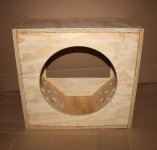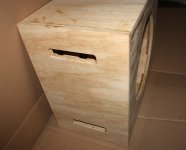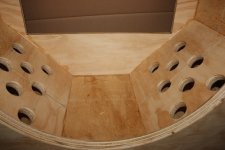constructing a new bass box right now
and had a few like this one
for strongest possible result I decided to glue the wood plugs with 2-component epoxy
That plywood is not the best quality it will have voids all over the place, high quality birch ply with more ply layers is much better, especially for subwoofers, I'd consider using 4mm bitumen pads for the internal walls or the panels will act like woofers themselves.
I have a theoretical view on the voids.
I have read that the voids may have loose pieces which rattle about under vibration, because we don't know where the voids are on the panels there could be some next to each other which would make them bigger. For piece of mind I use the highest quality birch ply with 9 ply layers in 18mm. Its much stronger than 6 or 7 ply layers and seems to have much less and smaller voids. I believe the more glue layers will help.
I have read that the voids may have loose pieces which rattle about under vibration, because we don't know where the voids are on the panels there could be some next to each other which would make them bigger. For piece of mind I use the highest quality birch ply with 9 ply layers in 18mm. Its much stronger than 6 or 7 ply layers and seems to have much less and smaller voids. I believe the more glue layers will help.
Voids in the plywood laminates represent a loss of strength in that the bond between plies is interrupted by the void. It also acts to weaken joints where the plywood is then edge-glued in an assembly in that the void will interrupt the continuity of the bond. The impact is obviously a function of the percentage of the material that contains voids. Even the best 13 ply material may show a few small voids where individual strips of a ply meet. Practically speaking the number and size of voids in the plys are a good indicator of the care with which the plywood was manufactured. A producer who is careless about the alignment of plys might also be careless about the adhesive chemistry, the temperatures and pressures used during lamination, etc. All you need to do is rip a sheet of plywood and have major voids and delamination revealed to understand that it is best to begin a project with high quality material if you value the time you spend building.
Cut an old paint stick & trim it to size or sub floor calking.
+1
You can find 1/8" trim stock at hardware and/or craft stores.
Voids in the plywood laminates represent a loss of strength in that the bond between plies is interrupted by the void. It also acts to weaken joints where the plywood is then edge-glued in an assembly in that the void will interrupt the continuity of the bond. The impact is obviously a function of the percentage of the material that contains voids. Even the best 13 ply material may show a few small voids where individual strips of a ply meet. Practically speaking the number and size of voids in the plys are a good indicator of the care with which the plywood was manufactured. A producer who is careless about the alignment of plys might also be careless about the adhesive chemistry, the temperatures and pressures used during lamination, etc. All you need to do is rip a sheet of plywood and have major voids and delamination revealed to understand that it is best to begin a project with high quality material if you value the time you spend building.
That's actually a good explanation, but I thought the most important feature of speaker design was stiffness rather than strength of the material. Perhaps voided material has less stiffness as well, but I wonder if the number voids in a given piece of regular (and much cheaper) furniture grade plywood would make a truly significant, audible difference in the overall sound of the cabinet (particularly a relatively small cabinet). I have my doubts.
The possibility of loose material vibrating is another matter. That would truly make a significant difference to sound quality, but has anyone ever had this happen? I'm just curious about the real chances or possibilities of this happening (as opposed to the purely theoretical possibility that it can happen). After all, if the chance is very low, then the difference in cost between regular and baltic plywood (particularly in certain regions) may be more difficult to justify for some people.
I also like the idea of looking for clues regarding the quality of the workmanship of the product. But you can do that with regular plywood as well (visual and tactile inspections of the plywood boards can help).
I'm just worried that all this talk about baltic plywood has taken on a certain normative tone that would unfairly pressure people to buy the more expensive baltic plywood when the normal furniture grade plywood would serve just as well (in real world listening tests). The difference in cost might be significant for some people and I'm not sure there is a corresponding proportional difference in audio qualities between one grade and another, that's all. If there's not, then most people may well be justified in going with the less expensive furniture grade plywood without feeling like they're compromising the quality of their speakers in any significant way.
It isn't necessary to buy high end Baltic birch to get sound plywood. The challenge is knowing the quality of the plywood as it sits on the rack in the store. If I go to my specialty plywood supplier and pay $90 for a 4x8 sheet of prefinished maple plywood, my experience is that it will be sound and essentially void free. I know this because he supplies professionals building cabinets for a living who won't tolerate substandard material. Recently I have bought two sheets of "furniture grade" birch plywood at the local Home Depot for about $40 and been pleasantly surprised to find it of good quality as I ripped it down to make plinth bases for my recently built kitchen cabinets. It is certainly good enough to make speaker cabinets. But I also know that big box stores sell plywood of dodgy quality as well that literally comes apart at the seams. So in DIY speak, you can get quality transistors from eBay sellers, but it's a crapshoot so many of us restrict our shopping to Digikey, Newark, etc. Plywood is similar in that there are suppliers with consistent quality at higher price or you can take your chances in pursuit of a bargain. Good luck!
Yes Phil I think cabinet stiffness is more important than material strength, hence why bracing producing a great affect on the cabinets vibrating. I think this thread was recommending people to buy better quality birch ply when I think its all personal choice. I like to make my cabinets as soundproof as I can yet I still like the sound of cabinet walls from 12mm birch ply in certain types of music. My first cabinets (20 litre 2-ways) I made from cheap low quality plywood (7 layers) from a wholesaler and it sounded awful, so i went out and bought MDF with same cabinet size and bracing and it sounds much better for bass (my speaker design intention) am now putting a 4mm plywood skin over the MDF and a 'knucle test' is much better. Am currently helping a friend with his first project too with high quality birch ply and I love the stuff, harder to work with though. Sounds bizarre but I've found that shouting at different materials of wood the same size gives a good idea of the differences between them, loudspeakers will be totally different of course. As Kevin also says it's the quality of workmanship that matters a lot.
Last edited:
- Status
- This old topic is closed. If you want to reopen this topic, contact a moderator using the "Report Post" button.
- Home
- Design & Build
- Construction Tips
- How to seal gaps is wood?


